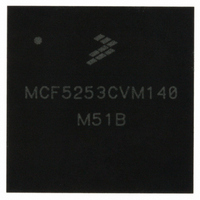MCF5253CVM140 Freescale Semiconductor, MCF5253CVM140 Datasheet - Page 429

MCF5253CVM140
Manufacturer Part Number
MCF5253CVM140
Description
IC MPU 32BIT 140MHZ 225-MAPBGA
Manufacturer
Freescale Semiconductor
Series
MCF525xr
Datasheets
1.MCF5253VM140J.pdf
(34 pages)
2.MCF5253VM140J.pdf
(8 pages)
3.MCF5253VM140J.pdf
(648 pages)
4.MCF5253VM140J.pdf
(2 pages)
Specifications of MCF5253CVM140
Core Processor
Coldfire V2
Core Size
32-Bit
Speed
140MHz
Connectivity
CAN, EBI/EMI, I²C, QSPI, UART/USART, USB OTG
Peripherals
DMA, WDT
Program Memory Type
ROMless
Ram Size
128K x 8
Voltage - Supply (vcc/vdd)
1.08 V ~ 1.32 V
Data Converters
A/D 6x12b
Oscillator Type
External
Operating Temperature
-40°C ~ 85°C
Package / Case
225-MAPBGA
Family Name
MCF5xxx
Device Core
ColdFire V2
Device Core Size
32b
Frequency (max)
140MHz
Instruction Set Architecture
RISC
Supply Voltage 1 (typ)
1.2/3.3V
Operating Supply Voltage (max)
1.32/3.6V
Operating Supply Voltage (min)
1.08/3V
Operating Temp Range
-40C to 85C
Operating Temperature Classification
Industrial
Mounting
Surface Mount
Pin Count
225
Package Type
MA-BGA
Lead Free Status / RoHS Status
Lead free / RoHS Compliant
Number Of I /o
-
Eeprom Size
-
Program Memory Size
-
Lead Free Status / Rohs Status
Compliant
Available stocks
Company
Part Number
Manufacturer
Quantity
Price
Company:
Part Number:
MCF5253CVM140
Manufacturer:
FREESCALE
Quantity:
300
Company:
Part Number:
MCF5253CVM140
Manufacturer:
Freescale Semiconductor
Quantity:
10 000
Part Number:
MCF5253CVM140
Manufacturer:
FREESCALE
Quantity:
20 000
Company:
Part Number:
MCF5253CVM140J
Manufacturer:
Freescale Semiconductor
Quantity:
10 000
- MCF5253VM140J PDF datasheet
- MCF5253VM140J PDF datasheet #2
- MCF5253VM140J PDF datasheet #3
- MCF5253VM140J PDF datasheet #4
- Current page: 429 of 648
- Download datasheet (8Mb)
All transfers between FIFO and host IP or DMA IP bus are zero wait states transfer, so high speed transfer
between FIFO and DMA/host bus is possible.
When a PIO access is performed during a running DMA transfer, the DMA transfer will be paused, the
PIO access done, and the DMA transfer will resume again.
23.3.1
The interface offers two operation modes that can be used together:
Freescale Semiconductor
•
•
•
The PIO mode is a slow protocol, mainly intended to program the ATA disc drive, but also possible
to use to transfer data to/from the disc drive. During PIO mode, the FIFO is not active.
Second protocol. This protocol is the DMA mode access. DMA mode is started by the ATA
interface after receiving a DMA request from the drive, and only if the ATA interface has been
programmed to accept the DMA request. In DMA mode, either multiword DMA or ultra DMA
protocol is used on the ATA bus. Once started, data transfer is organized between the ATA bus and
the FIFO. Data transfer will pause to prevent FIFO overflow / FIFO underflow. Data transfer will
resume when there is again space in the FIFO, or when the FIFO has been refilled. During DMA
transfer, there is no direct interface between the ATA bus and the host IP or host DMA IP bus.
Instead, the transfer takes place between the ATA bus and the FIFO; the FIFO informs the host
DMA unit when it needs to be refilled or emptied. In this case, it sends an ALARM flag to the host
DMA. When the host DMA receives the fifo_tx_alarm, it should write some data to the FIFO.
(typically 32 bytes). When the host DMA receives the fifo_rcv_alarm, it should read some data
from the FIFO (typically 32 bytes). The FIFO filling level at which the alarms are produced, is
programmable. For completeness, there is a third alarm associated with the host DMA operation
fifo_txfer_end_alarm. This alarm signals the end of the transfer, and requests the smart DMA to
take steps to complete the transfer: transfer the bytes remaining in the FIFO to the host memory,
and inform the host CPU the transfer is completed.
PIO Mode
An access to the ATA bus in PIO mode occurs whenever a ATA PIO register is read or written by
the host CPU or the host (smart) DMA unit. During a PIO transfer the incoming IP bus cycle is
translated to an ATA PIO bus cycle by the ATA protocol engine. No buffering of data occurs, so
the host CPU or host DMA cycle is stalled until the ATA bus read data is available on read, or is
stalled until the IP bus data can we put on the ATA bus during write.
PIO accesses can be done to the bus at any time, even during a running ATA DMA transfer. In this
case, the DMA transfer is paused, the PIO cycle is completed, and the DMA transfer is resumed.
DMA Mode
In DMA mode, data is transferred between the ATA bus and the FIFO. Two different DMA
protocols are supported on the ATA bus: ultra DMA mode and multiword DMA mode. Selection
is made using a control register bit.
A DMA transfer will be started when DMA mode transfer has been enabled by writing some
control bit, and when the drive connected to the ATA bus pulls its DMARQ line high.
During an ATA bus DMA transfer, data is transferred between the ATA bus and the FIFO. The
transfer will pause to avoid FIFO overflow and FIFO underflow.
Modes of Operation
MCF5253 Reference Manual, Rev. 1
Advanced Technology Attachment Controller (ATA)
23-3
Related parts for MCF5253CVM140
Image
Part Number
Description
Manufacturer
Datasheet
Request
R
Part Number:
Description:
Mcf5253 Coldfire? Microprocessor Data Sheet
Manufacturer:
Freescale Semiconductor, Inc
Datasheet:
Part Number:
Description:
Manufacturer:
Freescale Semiconductor, Inc
Datasheet:
Part Number:
Description:
Manufacturer:
Freescale Semiconductor, Inc
Datasheet:
Part Number:
Description:
Manufacturer:
Freescale Semiconductor, Inc
Datasheet:
Part Number:
Description:
Manufacturer:
Freescale Semiconductor, Inc
Datasheet:
Part Number:
Description:
Manufacturer:
Freescale Semiconductor, Inc
Datasheet:
Part Number:
Description:
Manufacturer:
Freescale Semiconductor, Inc
Datasheet:
Part Number:
Description:
Manufacturer:
Freescale Semiconductor, Inc
Datasheet:
Part Number:
Description:
Manufacturer:
Freescale Semiconductor, Inc
Datasheet:
Part Number:
Description:
Manufacturer:
Freescale Semiconductor, Inc
Datasheet:
Part Number:
Description:
Manufacturer:
Freescale Semiconductor, Inc
Datasheet:
Part Number:
Description:
Manufacturer:
Freescale Semiconductor, Inc
Datasheet:
Part Number:
Description:
Manufacturer:
Freescale Semiconductor, Inc
Datasheet:
Part Number:
Description:
Manufacturer:
Freescale Semiconductor, Inc
Datasheet:
Part Number:
Description:
Manufacturer:
Freescale Semiconductor, Inc
Datasheet:











